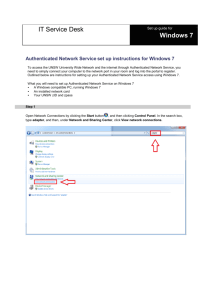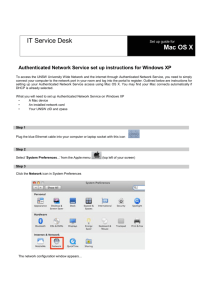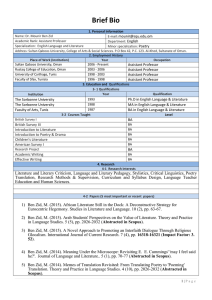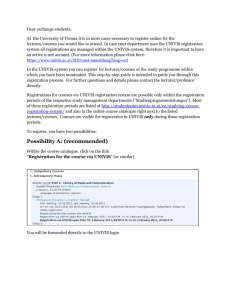D-PHY - Keysight
advertisement
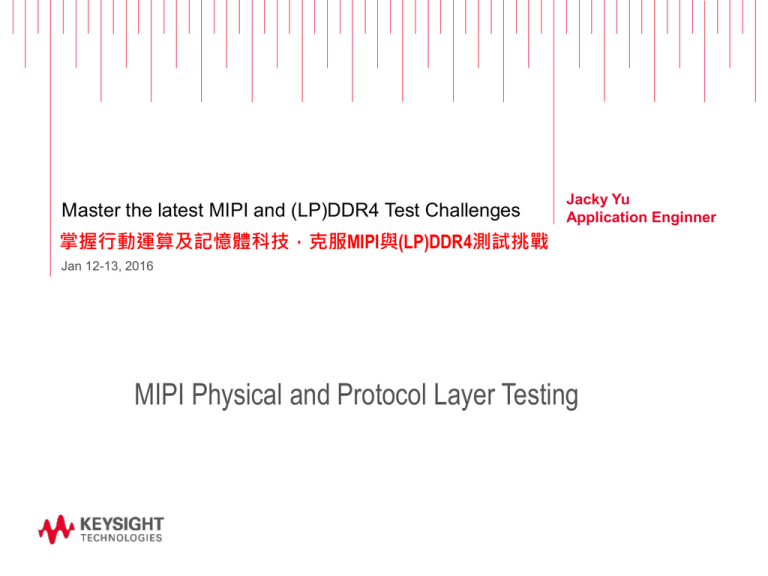
Master the latest MIPI and (LP)DDR4 Test Challenges Jacky Yu Application Enginner 掌握行動運算及記憶體科技,克服MIPI與(LP)DDR4測試挑戰 Jan 12-13, 2016 MIPI Physical and Protocol Layer Testing Agenda MIPI Overview and Standards Update • MIPI PHY Roadmap • Other developments UFSA Compliance Program Overview Measurement Applications and Solutions Update and Roadmap • TX Testing • RX Testing • Protocol Testing Page 2 MIPI = Mobile Industry Processor Interface Goals – Structure the intestines of mobile devices ranging from smartphones to wireless-enabled tablets and netbooks – Benefit the entire mobile industry by establishing standards for hardware and software interfaces – Enabling reuse and compatibility making system integration less burdensome – The distinctive requirements of mobile terminals drive the development of MIPI Specifications • Power saving / battery life • Bandwidth on demand MIPI M-PHY Receiver Test Webinar Page 3August 2013 MIPI’s Layered Approach for Application Standards Page 4 Page 4 MIPI – Mobile Influenced Automotive – “Smart Car” • Advanced Driver Assistance Systems (ADAS) • Cameras (MIPI CSI) / Displays (MIPI DSI) • In-Vehicle Infotainment (IVI) • Sensors (MIPI I3C) Page 5 Agenda MIPI Overview and Standards Update • MIPI PHY Roadmap • Other developments UFSA Compliance Program Overview Measurement Applications and Solutions Update and Roadmap • TX Testing • RX Testing • Protocol Testing Page 6 Key Features of PHY-Layer Standards Vers. Max HS Symbol Rate (GSym/s) D-PHY C-PHY M-PHY 1.0, 1.1 1.5, continous 1.2 2.5, continous 2.0 4.5, continous 1.0 2.5, continous 1.1 3.0, continuous 1.0, 2.0 1.5/2.9 discrete 3.0 5.8, discrete 4.0 11.6, discrete Data format LP nondiff. “RZ“ (type II: NRZ) Clock Recovery Forward Source Synchronous (DDR) NA HS diff. NRZ, 3-phase 3-level diff. type I: PWM Clocking embedded RX de-skew Logical EQ None None TX None TX None diff. NRZ embedded PLL-based TX TX & RX Page 7 MIPI M-PHY Spec Roadmap – V4.0 adopted August 2015 – V4.1 Spec goals • Tighten spec/conformance of digital interface (RMMI) • Protocol/PHY optimizations • No activity in subgroup after lead from Intel has been assigned to other tasks. – Items in discussion for next Gen M-PHY: • • • • • Advanced encoding and scrambling Optional data rate granularity Short channel reach applications (<20dB loss channel) Change jitter BER from 1e-10 to 1e-12 Power efficiency optimations Page 8 M-PHY Link Example LINK SUB-LINK MIPI M-PHY M-PORT LANE PINs TXDP M-TX PIF LINE RXDP M-TX TXDN M-RX M-RX PIF M-RX M-RX PIF M-TX M-TX PIF RXDN PINs TXDP M-TX PIF LINE RXDP M-TX TXDN RXDN PINs RXDP M-RX PIF LINE PINs TXDP M-RX RXDN LANE MANAGEMENT LANE MANAGEMENT PINs • • • • Lanes are unidirectional Signaling: differential 8B/10B coded Transmisssion may appear in burst • Embedded clock • PLL type CDR, needs to synch at the beginning of every burst TXDN PINs LANE M-PORT SUB-LINK LINK MIPI M-PHY options – High speed and (lower speed) low power mode (same as in D-PHY) – High and low voltage swing operation can be commonly selected for both modes – Terminated (100 Ohm) or not terminated operation (for power saving purposes) can individually be selected per mode 9 Page 9 Low Power Modes High Speed Modes MIPI M-PHY Data Rates and Module Types fref = 19.2, 26, 38.4 or 52 MHz NT = Not Terminated RT = Resistively terminated • High Speed Gears / data rates valid for both module types • Type II module only used for Dig_RF_v4 1010 10 Page 10 Type-I RX State Machine DIF-P for 9 to 20 UIHS + TPWM_PREPARE. Ready for LINE-CFG within that period (with respect to maximum allowed data rate in configured PWM-GEAR) HS-MODE All transitions initiated by TX signalling and commands DIF-N – Hibern8: “deepest” power saving state DIF-N to DIF-P Transition STALL HS-BURST RCT DIF-N for 9 to 20 UIHS RCT • Transition into “Sleep”or “Stall” signaled by driving a DIF-N (= logical “0”) No direct transition to data transfer 9 PWM-b1 DIF-P to DIF-N Transition at Completion of MODE-LCC RCT DIF-Z to DIF-N Transition LINE-CFG DIF-N DIF-N to DIF-P Transition SLEEP PWM-BURST (> 9 PWM-b0) + PWM-b1 RCT LS-MODE Update of INLINE configuration settings during SLEEP or STALL after Re-Configuration Trigger (RCT) = State = State with sub-FSM HIBERN8 DIF-P to DIF-N Transition DIF-Z = Global State = Power Saving (SAVE) State = LS-MODE State (PWM) A LINE-RESET = Special State UNPOWERED 11 DIF-P RESET Power Supply Off DIF-P for TLINE-RESET-DETECT POWERED • transition into low power PWM burst mode signaled by DIF-P (= logical “1”) – “Stall: line is driven DIF-N = NRZ-LINE Condition = PWM-LINE Condition Power Supply On – “Sleep”: line is driven DIF-N = HS-MODE State RESET Completion DISABLED • data line kept open and no signal is driven (DIF-Z) = CONFIG Condition = Extra CONFIG Option (without MC) • transition into high speed NRZ burst mode signaled by DIF-P ACTIVATED 1110 MIPI M-PHY Receiver Test Webinar Page 11 August 2013 ADAPT State SAVE state: STALL or SLEEP LINE state: DIF-N; Unconstrained length PREPARE LINE state: DIF-P; Function: request for BURST SYNC Any 8b10b data symbols with 7/10 edge density. Optional for PWM-G6 and PWM-G7. Function: clock/bit synchronization Duration: 0 to 15 SI or 24+P SI By default extended until MK0 First MARKER0 for symbol synchronization, RD initialization, and start of PAYLOAD PAYLOAD symbols: DATA & MK0, MKn; FLR for Idling if no TX data available TAIL-OF-BURST Function: Run length violation indicating a change of state ADAPT Function: HS-RX equalizer adaptation and clock/bit synchronization Duration: 650*(n+1) or 650*2n bits HS-BURST ADAPT STALL PREPARE DIF-N DIF-P SYNC MK0 FLR 8b10b Encoded DATA TAIL-OF-BURST MK0 PWM/SYS-BURST SLEEP PREPARE DIF-N DIF-P MKn xxx = SAVE State xxx = 8b10b Encoded Symbol = BURST (sub-)State xxx = Symbol for M-RX = Optional State Transition xxx = Symbol for M-RX = Symbol for M-RX xxx = Symbol for Protocol Page 12 MIPI D-PHY Spec Roadmap D-PHY 2.0 (2015) – High Frequency Clock(DDR) forwarded architecture targeted at max data rate of 4.5Gbps. – Spread Spectrum Clocking (SSC) support on clock to mitigate emissions concerning EMI compliance. – Scrambling support at the controller level to reduce data interference with the radio frequencies. – Channel Support: 14inch(@4.5Gbps), 21inch(@2.5Gbps) – Eye Diagram Conformance for Tx/Rx. Jitter decomposition into DJ/RJ – Support 4K Display with Chip on Glass implementation. – Test Mode. Informative chapter. D-PHY 2.1 – In discussion: Alternate LP mode Page 13 D-PHY Universal Lane Module Functions – Lane consisting of 2 wires, Dp and Dn – TXs and Rxs: Bidirectional PPI – Contention Detection (LP only) LP-TX (appendix) – Two set‘s of TXs / RXs (HS & LP) TX HS-TX Clock Data Lane Control and Interface Logic Dp Dn HS-RX RT R RX LP-RX Ctrl LP-CD CD Protocol Side – HS-mode: • Small Amplitude, terminated (option) • Data format: NRZ • Signaling: differential – LP-mode: • Large Amplitude, unterminated • Data format: RZ • Signaling: non-differential Line Side Page 14 D-PHY Two Data Lane Phy Configuration Clock Multiplier Unit Ref Clock Controls I APPI = Abstracted PHY-Protocol Interface (complete PHY, all Lanes) PPI = PHY Protocol Interface (per Lane, some signals can be shared with multiple Lanes) Q PPI APPI PHY Adapter Layer PPI PPI D-PHY Master Clock Lane Module D-PHY Slave Clock Lane Module PPI D-PHY Master Data Lane Module D-PHY Slave Data Lane Module PPI D-PHY D-PHY PPI Master Data Lane Module Slave Data Lane Module PHY PHY Master Side Slave Side APPI PHY Adapter Layer – Source synchronous forwarded double data rate clocking – Data-rate completely agile, no discrete operating frequencies, continous range – RX testing is basically stressing set-up- and hold- time conditions (eye closure mainly due to DDJ and skew between Data and Clock) 15 Page 15 D-PHY Physical Layer Timing Diagram Transition LP to HS mode, HS_clk active earlier / longer High speed mode, Differential signaling, 100 ohm termination, source synchronous DDR clocking Low power mode Unterminated, not differential, clock embedded within data Page 16 MIPI C-PHY Spec Roadmap C-PHY 1.0 (adopted October 2014) – 2.5Gsps – Effective data rate up to 5.7Gbps C-PHY 1.1 in adoption – Up to 3Gsps – TX Deemphasis Page 17 C-PHY Universal Lane Module Functions PPI (appendix) Data In Data Out TX Ctrl Logic Data IF logic – TXs and RXs: Bidirectional LP-TX – Contention Detection (LP only) A B C Esc Encoder TX Mapper HS-Serialize Encoder HS-TX Sequences Clocks-in DeMapper Clocks-out HSDeserialize Decoder Data Sampler HS-RX RT RX LP-RX Data Out Protocol Side Ctrl Decoder Ctrl IF logic State Machine (incl Enables, Selects and System ctrl) – HS-mode: • Small Amplitude, always 50 W “star-type“ termination • Data format: 3-phase / 3-level • Signaling: 3 wires forming a HS-lane – LP-mode: • Large Amplitude, unterminated • Data format: RZ • Signaling non-differential Esc Decoder Data In – Two set‘s of TXs / RXs (HS & LP) LP-CD Error detect CD Line Side Page 18 3 Phase Encoding Concept for C-PHY (HS-mode) – A data encoding technique utilyzing trios rather than pairs of wires • 50 Ohm “star-type“ termination • Utilyzes differential receivers, rejecting common mode noise • Drivers work similar to D-PHY but control 3 instead of 2 outputs – Both clock and data are encoded and transported together in a single trio • Always a transition at every symbol boundary, which simplifies clock recovery and allows data rate to be completely agile 19 Master side +V PU_A “B” to “A” (-x state) “A” Z0=50 + 50 +V PD_A PU_B -V/2 Rx_AB “0” Rx_BC “1” Rx_CA “1” 50 “B” Z0=50 ZID/2=50 + PD_B +V/4 +V PU_TC Slave side ZID/2=50 100 100 “C” Z0=50 ZID/2=50 + +V/4 - A B C Page 19 3-phase Signal Example HS signal only A B C A B C • Clean HS signal no jitter no skew • separated (offset-shifted, left) and overlaid (same offset, right) note: for each UI each voltage level appears exactly once! Page 20 C-PHY Block diagram Positive Polarity States “A” to “B” (+x state) +V PU_A “A” 50 Z0=50 +V/2 +V +V PU_A + Rx_AB “1” “B” Z0=50 -V/4 Rx_BC “C” Z0=50 100 PD_TC 50 -V/4 Rx_CA “B” +V/4 “C” 100 Z0=50 +V PU_TA 100 PD_TA 100 +V PU_B “B” to “C” (+y state) “A” Z0=50 + 100 “0” +V/4 + “0” PU_TA 100 PD_TA 100 +V 50 “B” +V/2 +V Rx_BC “1” “C” Z0=50 + 50 -V/4 + +V/4 Rx_CA “B” Z0=50 +V PU_A “C” to “A” (+z state) “A” Z0=50 + -V/2 + “C” 50 Z0=50 100 “B” PD_TB 100 Z0=50 PU_C + -V/4 +V Rx_AB Rx_BC 50 “C” Z0=50 “0” - Rx_CA “A” 50 Z0=50 Rx_CA “1” “1” +V/4 +V Rx_AB “1” Rx_BC “1” Rx_CA “0” - PU_TB 100 “B” PD_TB 100 Z0=50 ZID/2=50 + +V/4 +V PD_C Slave side ZID/2=50 PD_A - PU_C ZID/2=50 +V/2 “A” to “C” (-z state) + “0” + PD_C Master side Slave side ZID/2=50 +V “0” ZID/2=50 +V/4 - PU_TB Rx_BC - PD_C PU_A -V/4 “1” - ZID/2=50 50 +V PD_A Rx_AB ZID/2=50 + “0” Slave side - - Master side “1” ZID/2=50 +V PU_C ZID/2=50 Z0=50 50 PD_B - PU_C “A” PU_B + PD_C PD_TC Rx_AB +V ZID/2=50 PD_B “C” to “B” (-y state) Master side Slave side Z0=50 Rx_CA - ZID/2=50 -V/4 “1” ZID/2=50 - Master side Rx_BC - PU_TC + “0” + ZID/2=50 Rx_AB ZID/2=50 +V 100 -V/2 Z0=50 PD_B “0” Slave side ZID/2=50 + PU_B + 50 Z0=50 50 +V PD_A ZID/2=50 +V PU_TC “A” - PU_B PD_B Slave side ZID/2=50 PD_A Negative Polarity States “B” to “A” (-x state) Master side Master side “C” 50 Z0=50 ZID/2=50 + -V/2 - – Coding rules and possible wire states: • 27 possible wires states • 6 allowed wire states (+x, -x, +y, -y, +z, -z) only those states with different voltage on each wire • From one symbol to the next symbol only 5 wire states are possible, because a transition is required for CR • Theoretical coding gain: log2(5) = 2.32 • Practically usable gain is 2.28 by sending 16 bits in 7 symbols Drawing showing T2 Driver type w/ active mid-level 21 Page 21 C-PHY Block diagram Positive Polarity States “A” to “B” (+x state) +V PU_A “A” 50 Z0=50 +V/2 +V +V PU_A + Rx_AB “1” “B” Z0=50 -V/4 Rx_BC “C” Z0=50 PU_A 100 PD_TC -V/4 Rx_CA +V PU_TA 100 PD_TA 100 +V PU_B “B” to “C” (+y state) “A” Z0=50 “C” 100 Z0=50 + -V/4 50 “B” Z0=50 100 PD_TA 100 +V + +V/2 +V Rx_BC “C” Z0=50 + 50 -V/4 Rx_CA “0” +V PU_A “C” to “A” (+z state) “A” Z0=50 “C” 50 PD_C -V/4 100 “B” PD_TB 100 Z0=50 + -V/4 Rx_BC “0” 50 “C” Z0=50 + +V/2 - Rx_CA “1” Z0=50 + Rx_AB -V/4 “1” -V/2 “C” Rx_BC “0” Rx_CA “1” Z0=50 - + +V/4 PD_TB 100 Z0=50 Rx_AB “1” + Rx_BC “1” Rx_CA “0” - 50 Rx_CA “0” Slave side ZID/2=50 +V/4 Z0=50 -V/4 ZID/2=50 +V “C” “0” - 100 “B” Rx_BC ZID/2=50 + - Z0=50 “1” ZID/2=50 ZID/2=50 100 Rx_AB + Z0=50 +V/2 “1” ZID/2=50 +V/4 PU_TB PD_C ZID/2=50 - +V PU_C ZID/2=50 Slave side - 50+V/4 + PD_A - Z0=50 - + “0” ZID/2=50 +V PD_C Rx_AB Rx_CA +V/4 “A” to “C” (-z state) “A” 50 - PU_TB PU_C PU_A + 50 +V PD_A +V Slave side “1” ZID/2=50 100 PD_TC Master side ZID/2=50 +V Z0=50 PU_TC - Master side Z0=50 50 +V PU_C ZID/2=50 Rx_BC + + PD_B “B” PD_B “1” - PU_C “A” PU_B ZID/2=50 + Slave side +V PU_TA - PD_B PD_C PD_TC “0” “A” +V/4 “C”PU_B to “B” (-y state) “B” Master side Rx_AB “0” ZID/2=50 +V Slave side Rx_AB ZID/2=50 PD_A 100 “0” ZID/2=50 “A” to “B” (+x state) - 50 - Master side + -V/2 Slave side - PU_TC ZID/2=50 + “B” +V 100 50 Z0=50 PD_B “0” ZID/2=50 +V PU_B + 50 Z0=50 Master side 50 +V PD_A ZID/2=50 +V PU_TC “A” - PU_B PD_B Slave side ZID/2=50 PD_A Negative Polarity States “B” to “A” (-x state) Master side Master side ZID/2=50 + -V/2 - midpoint voltage is stable at +V/2 (except for asymmetries during transitions (to be filtered by capacitor)) Drawing showing T2 Driver type w/ active mid-level 22 Page 22 C-PHY Block diagram Positive Polarity States “A” to “B” (+x state) +V “A” 50 Z0=50 +V/2 +V +V PU_A + Rx_AB “1” “B” Z0=50 -V/4 Rx_BC “C” Z0=50 PU_A 100 PD_TC -V/4 Rx_CA +V PU_TA 100 PD_TA 100 +V PU_B “B” to “C” (+y state) “A” Z0=50 “C” 100 Z0=50 + -V/4 50 “B” Z0=50 100 PD_TA 100 +V + +V/2 +V Rx_BC “C” Z0=50 + 50 -V/4 Rx_CA “0” +V PU_A “C” to “A” (+z state) “A” Z0=50 “C” 50 PD_C PU_TB -V/4 Z0=50 100 -V/4 50 “C” Z0=50 “0” +V/2 - Rx_CA Z0=50 “1” Rx_BC “0” -V/2 “C” Rx_BC “0” Rx_CA “1” Z0=50 - Rx_CA “0” ZID/2=50 + +V/4 + -V/4 - Slave side ZID/2=50 Rx_AB “1” ZID/2=50 + +V/4 +V PD_C -V/4 “1” Z0=50 “1” ZID/2=50 + Rx_AB - 100 PD_TB Z0=50 ZID/2=50 100 Rx_AB + Z0=50 +V/2 “1” ZID/2=50 +V/4 100 “B” Rx_BC “1” Rx_CA “0” 100W - PU_C ZID/2=50 + PD_C Rx_BC ZID/2=50 - +V - Slave side - 50+V/4 + PD_A PU_TB + Z0=50 - + “0” ZID/2=50 +V PU_C Rx_AB Rx_CA +V/4 “A” to “C” (-z state) “A” 50 100 “B” PD_TB PU_A + 50 +V PD_A +V Slave side “1” ZID/2=50 100 PD_TC Master side ZID/2=50 +V Z0=50 PU_TC - Master side Z0=50 50 +V PU_C ZID/2=50 Rx_BC + + PD_B “B” PD_B “1” - PU_C “A” PU_B ZID/2=50 + Slave side +V PU_TA - PD_B PD_C PD_TC “0” “A” +V/4 “C”PU_B to “B” (-y state) “B” Master side Rx_AB “0” ZID/2=50 +V Slave side Rx_AB ZID/2=50 PD_A 100 “0” ZID/2=50 “A” to “B” (+x state) - 50 - Master side + -V/2 Slave side - PU_TC ZID/2=50 + “B” +V 100 50 Z0=50 PD_B “0” ZID/2=50 +V PU_B + 50 Z0=50 Master side 50 +V PD_A ZID/2=50 +V PU_TC “A” - PU_B PD_B Slave side ZID/2=50 PD_A Negative Polarity States “B” to “A” (-x state) Master side Master side PU_A 50W “C” 50 Z0=50 ZID/2=50 + -V/2 - Drawing showing T2 Driver type w/ active mid-level 23 Page 23 C-PHY Block diagram Positive Polarity States “A” to “B” (+x state) +V “A” 50 Z0=50 +V/2 +V +V Rx_AB “1” “B” Z0=50 PU_B + 50 -V/4 Rx_BC “C” 100 Z0=50 + -V/4 Rx_CA +V PU_TA 100 PD_TA 100 +V PU_B “B” to “C” (+y state) “A” Z0=50 + -V/4 50 “B” 100 PD_TA 100 +V + Rx_BC “C” Z0=50 + 50 -V/4 Rx_CA +V PU_A “C” to “A” (+z state) “A” Z0=50 50 +V PD_A PU_TB Z0=50 100 PD_TB PU_C Rx_BC “0” 50 “C” Z0=50 +V/2 - Rx_CA “1” “1” Z0=50 +V ZID/2=50 + + ZID/2=50 50 + +V/2 Rx_BC Rx_BC “1” “C” Rx_CA “0” “0” +V/4 Rx_CA Z0=50 ZID/2=50 + “1” - -V/4 - Slave side ZID/2=50 Rx_AB “1” Z0=50 “0” ZID/2=50 “1” - Z0=50 Rx_AB - ZID/2=50 -V/2 Z0=50 -V/4 - +V/4 100 “B” ZID/2=50 + 100 PD_TB Rx_AB +V/4 +V +V/4 +V PD_C Slave side ZID/2=50 “A” to “C” (-z state) “A” 50 Rx_BC “1” Rx_CA “0” 50W - PU_C ZID/2=50 Rx_BC ZID/2=50 PD_A + PD_C +V PU_TB -V/4 +V + + “0” ZID/2=50 + “C” Master side 100 “B” Z0=50 PD_C Slave side Rx_AB “A” +V/4 + 50 PU_A -V/4 Z0=50 PD_C ZID/2=50 + Z0=50 50 - Master side 100 + “0” “0” ZID/2=50 PU_C +V PU_C ZID/2=50 Rx_AB - PD_B “B” PD_B “1” - PU_C “A” PU_B +V/2 +V PD_C PD_TC +V PU_TA ZID/2=50 PD_B “B” to “C” (+y state) + 100 Rx_CA +V/4 “1” +V “C” to “B” (-y state) PU_B 50 “B”Slave side Z0=50 Master side “0” + -V/2 Slave side PD_TA Z0=50 “C” 100 100 Slave side Rx_AB Z0=50 ZID/2=50 - “0” ZID/2=50 +V PU_TA - Master side “B” Z0=50 +V PU_TC ZID/2=50 100 50 PD_B “0” - PD_TC 50 +V PD_A ZID/2=50 +V PU_TC “A” - PU_B Master side PU_A + PD_B Slave side ZID/2=50 PD_A Negative Polarity States “B” to “A” (-x state) Master side Master side PU_A 100W “C” 50 Z0=50 ZID/2=50 + -V/2 - Drawing showing T2 Driver type w/ active mid-level 24 Page 24 Layers: Words, Symbols, Wire States – Mapper converts 16-bit word into 7 symbols (21 bits), 16/7 2.285 bits/symbol – In a group of 7 UI’s, total of 57=78,125 permutations • To send 16-bit word requires only 216 = 65,536 states – Parallel-to-Serial sends each symbol to the Encoder one at a time. – Encoder creates present wire state based on previous wire state and the 3-bit Symbol • Each 3-bit symbol has a Flip, Rotation and Polarity. – Wire state in each UI has 1 of 6 values, next state can be one of the 5 other values. • Requiring a transition is how the clock is encoded in each symbol. 21 = 7 symbols, 3 bits each. 3 bits define one of 5 state transitions Page 25 t0 t1 t2 t3 t4 t5 t6 ws0 ws1 ws2 ws3 ws4 ws5 ws6 A B C 3-Wire Receiver, (3) Symbol Decoder Each Wire State has 6 possible states. Tx_Flip, Tx_Rotation, Tx_Polarity The change on ABC from one Unit Interval to the next defines the symbol value. Symboln = f(wsn, wsn-1) 7-symbol to 16-bit (21) (16) DeMapper Rx_Flip, Rx_Rotation, Rx_Polarity Page 25 Rx_Data[15:0] A B C 16-bit word, output Symbol Encoder, (3) 3-Wire Driver Receive 7 symbols, output 16 bits Seven 3-phase-encoded wire states for each 16-bit word Serial-to-Parallel 16-bit to (16) 7-symbol (21) Mapper Parallel-to-Serial 16-bit word, input Tx_Data[15:0] Take in 16 bits, generate 7 symbols Flip, Rotate, Polarity, SN = f(wsN, wsN-1) -y W 011 100 00 0 01 0 10 0 B to A +z C to A 0 10 -x 010 000 011 001 011 001 010 000 Negative Polarity Page 26 001 1 01 +x A to B Positive Polarity 000 010 001 B to C 000 010 +y 001 011 00 1 011 00 0 01 0 CC CW C to B -z A to C Symbol decoding: Symbol value is a function of the change between the previous and present Wire State. Page 26 Document Status and Outlook D-PHY C-PHY M-PHY Vers. Max HS Symbol Rate (Gsym/s) / Gear 1.0, 1.1 1.5 1.2 2.5 2.0 4.5 1.0 2.5 1.1 3.0 1.0, 2.0 1.5/2.9 / G1, G2 3.0, 3.1 5.8, / G1, G2, G3 4.0 11.6, / G1, G2, G3, G4 Specification Board approved CTS Board approved v1.2r11, work in progress WG voting work in progress Board approved v1.0r11, work in progress WG approved work in progress v1.0, board approved Board approved v3.0r18, work in progress work in progress Page 27 Agenda MIPI Overview and Standards Update • MIPI PHY Roadmap • Other developments UFSA Compliance Program Overview Measurement Applications and Solutions Update and Roadmap • TX Testing • RX Testing • Protocol Testing Page 28 UFS Compliance Test Elements Device Test Test Executive Host Test System Interop Test HCI Compliance Test Executive Interop Test Executive Test Driver Operating System UFS HCI File System Emulated UFS Host UFS Device Driver Stack Emulated UFS Device UFS HCI UFS Device Verifies compliance with key elements of the UFS, UniPro and M-PHY specifications. Verifies overall system integrity and covers elements that might be missed by device and host tests. Certification of instrumentation and independent 3rd party test centers Page 29 UFS Certification Process Plugfests & Accredited Labs Adopter Member Products Compliance Committee UFS Compliance Test Spec Compliance Certificate Board of Directors Logo License UFS Test UFS Test Spec Procedures M-PHY/UniPro Test Procedures logo assures user that all compliance tests passed * JEDEC, MIPI Alliance and UFSA logos are the property of their respective organizations Page 30 UFS Compliance Test Specification Developed by the Reduce test redundancy Compliance Committee Test only the modes used by UFS Golden Hosts Golden Devices UFS Compliance Test Matrix for host and device testing Device DUTs Host DUTs Interoperability test configurations Page 31 Agenda MIPI Overview and Standards Update • MIPI PHY Roadmap • Other developments UFSA Compliance Program Overview Measurement Applications and Solutions Update and Roadmap • TX Testing • RX Testing • Protocol Testing Page 32 Test & Measurement Applications – Electrical Layer • TX & RX Conformance • Impedance & S-Parameters • BringUp & Debug – Protocol & Application Layer • Protocol Conformance • BringUp & Debug • Device Emulation • Performance Validation • Interoperability Page 33 Keysight MIPI Total Solution Coverage Transmitter Characterization Receiver Characterization Impedance/Return Loss Validation Protocol Stimulus and Analysis DSAQ93204A Infiniium N4903B/M8020A JBERT E5071C ENA Option TDR U4421A D-PHY CSI-2 / DSI Analyzer and Exerciser U4431A M-PHY Analyzer (UFS, UniPro, CSI-3, SSIC, M-PCIe) M8190 AWG U7238B D-PHY, U7249B M-PHY, N5467B C-PHY UDA InfiniiMax Probes DCA 86100D Wideband sampling oscilloscope 81250A ParBERT Scope Protocol Decoder Switch matrix N5465A InfiniiSim N2809A PrecisionProbe N1055A TDR/TDT N5990A Automated characterization N8802A CSI-2 / DSI N8807A DigRF v4 N8808A UniPro N8818A UFS N8809A LLI N8819A SSIC N8820A CSI-3 N8824A RFFE 54754A TDR/TDT Industry’s highest analog bandwidth, lowest noise floor/sensitivity, jitter measurement floor with unique cable/probe correction Highest precision jitter lab source with automated compliance software for accurate, efficient, and consistent measurement Precision impedance measurements and S-Parameter capability Fast upload and display, accurate capture, intuitive GUI and customizable hardware. Correlate physical and protocol layer. Page 34 Agilent / Keysight Solutions for MIPI RX PHY-test 2016 and beyond: M8085A w/ M8195A rev. 2 M8000 family of BER test solutions... M-PHY J-BERT N4903B N5990A-165 J-BERT M8020A N5990A-165,-365 C-PHY AWG M8190A M8085A-CT1,-CTA D-PHY ParBERT 81250 N5990A-165 2013 AWG M8195A rev. 2 M8085A-xT1,-xTA 2015 2016 Page 35 Master the latest MIPI and (LP)DDR4 Test Challenges 掌握行動運算及記憶體科技,克服MIPI與(LP)DDR4測試挑戰 Jan 12-13, 2016 DDR4/LPDDR4 Scopes Agenda – Roadmap update – Introduce new LPDDR4/DDR4 debug tool – Demo Page 37 Roadmap Update Work in Progress Planned but not staffed Investigation phase 2015 Oct Nov 2016 Dec Oct 16th : LP/DDR4 debug tool with eye diagram Jan Feb Mar Feb 3rd : HMC compliance app Mar 15th : 5.60 release with BER contour capability Nov 1st : QuickSilver framework release Mar 1st : QuickSilver 2.0 release Apr May Jun Jul Aug Sep Jun 1st : BER contour support in LP/DDR4 app Jun 1st : Multiscope support Jun 1st : LP/DDR4 app to adopt QuickSilver framework 3D XPoint Technology Page 38 Why use the Debug Tool? DDR Validation Test Flow 1. Understand signal behavior • • 2. Read and write separation methods 3. Measurement method 5. Debug 4. Compliance test and simulation I need an easy way to debug my DDR test failures. I need a fast way to get to the root cause of the problem. Page 39 DDR4/LPDDR4 Debug Tool What is it? • Identify read and write bursts. • Make pre and post compliance measurement on saved traces. • Collect statistical result with multi burst measurement. • Navigate to measurement and read/write burst. • Draw eye diagrams on saved read/write data. • Display multiple eye diagrams. Page 40 Identify read/write burst • Reports number of read/write bursts. • Marks start and end of read/write burst. Read burst Write burst Page 41 Navigation Read and Write Bursts • Write Write Navigate to each read and write burst to check if start and end of a burst is identified correctly. Write Page 42 Pre and Post Compliance Measurement Statistical Result • • Report timing and electrical measurement results – min, max, mean. No auto-scaling done on saved traces to speed up measurement time. Page 43 Navigation Measurement • • • • • Max Specify number of bursts to measure. Marks all valid measurements in the trace. Report number of measurement. Navigate to the measurement. Mark min and max measurement Min Page 44 Measurement • Mark measurement thresholds Measurement threshold • DQS at 0V • DQ at VIH/VIL Page 45 Eye diagram Offline view of data eye diagram – View read/write eye diagram with offline waveform files from the scope or ADS simulation tool. – View multiple data eye diagrams to pin point data lane of concern. – View both read and write eye diagrams at the same time. – View before and after probe correction with InfiniiSim data eye diagrams. Page 46 Eye diagram Multiple read/write eye diagrams After InfiniiSim After InfiniiSim Before InfiniiSim Before InfiniiSim View multiple data lane eye diagrams to pin point small data eye for further testing. Page 47 HMC Compliance App HMC Compliance app plan: Supports all Transmitter tests listed in Hybrid Memory Cube Specification 2.0. A PRBS pattern is usually used to generate test sequences • PRBS15 for Transmitter testing • PRBS31 for Receiver testing – TBD (waiting for response from PL24) Supports De-embedding feature - InfiniiSim – Assuming a 3rd harmonic requirement: 45Ghz BW Scope Page 48 QUESTIONS Page 49

